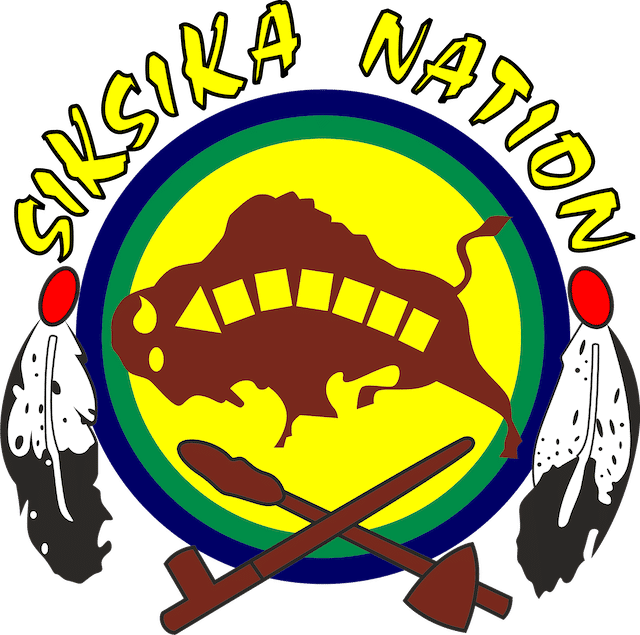
History Of
Siksika Nation
Since time immemorial, the Children of the Plains, the Siksikai’tsitapi – Blackfoot People, have lived in and protected a territory that stretches from the North Saskatchewan River in present day Alberta and Saskatchewan to the Yellowstone River in the state of Montana, from the Continental Divide in the west to Regina in the province now known as Saskatchewan.
Today, Siksika Nation population is approximately 7800+ and is part of the Siksikaitsitapi – Blackfoot Confederacy. The Siksikaitsitapi refers to four Indigenous Nations which make up the Blackfoot people: the Siksika (Blackfoot), the Kainai (Many Chiefs), the Apatohsipiikani (Northern Peigan) and Amsskapipiikani (Southern Peigan). Siksikai’powahsini (Blackfoot Language) is the language of the Siksikaitsitapi.
About
Siksika Nation
- Siksika Nation population is approximately 7800+
- Siksika Nation is located one hour’s drive east of the city of Calgary, and three kilometres south of the Trans-Canada Highway #1.
- Siksika Nation Administration and Business district are located adjacent to the Town of Gleichen.
- Siksika (Blackfoot) is the language of Siksika Nation. Siksika means Blackfoot.
- Siksika Nation is part of the Siksikaitsitapi – Blackfoot Confederacy which includes Kainai Nation, Piikani Nation and Aamskapi Piikani (Blackfeet Nation).
Vision Statement
To provide a progressive Administration providing excellent and resilient public services with equal opportunities.
Mission Statement
VALUES
- Respect – We show respect and honor to all.
- Integrity – We practice integrity in all of our actions (work) honestly and ethically.
- Humility – We serve with empathy.
- Accountability – We are responsible for our actions and admit our mistakes..
Pre-Treaty Government
Prior to the 1800s, the Siksika Government structure was made up of thirty-six (36) Clans. This translated into a total of 18,000 Siksika. Clans grouped themselves into three (3) main tribes; each were responsible for maintaining the boundaries of the Blackfoot Confederacy.
To the North were the North Blackfoot, who camped along the North Saskatchewan River. To the South were the South Blackfoot who protected lands as far South as the Missouri River. The Middle Blackfoot were responsible for all lands between the Rocky Mountains and the Cypress Hills.
1830
Missionaries came, and influence began within the Siksika (Blackfoot) Confederacy. Indian Affairs in Ottawa ceased being a branch of the military and became part of the Public Service.
1800 - 1882
Raids and wars fought by Siksika War Chiefs of the Confederacy resulted in numerous Chiefs being killed or wounded. Unknown diseases also devastated the Siksika people between 1864 and 1870. Siksika became vulnerable and a subsequent decrease in buffalo added to the hardships of the Chiefs and people.
1874
Whiskey fort built at Blackfoot Crossing. This was the year the N.W.M.P. arrived in the Confederacy’s Territory.
1865
Father Lacombe (R.C. Missionary) first met Chief Crowfoot.
1876
Indian Act of 1876: An Act to amend and consolidate the laws respecting Indians.
1877
Treaty Number 7 was signed at Blackfoot Crossing in Siksika.

Isapo-muxika – Chief Crowfoot
Isapo-muxika – Chief Crowfoot (1830 – 1890) was chief of Siksika Nation. His parents, Istowun-eh’pata (Packs a Knife) and Axkahp-say-pi (Attacked Towards Home) from Kainai. He was only five when his father was killed, and a year later, his mother remarried to Akay-nehka-simi (Many Names) of the Siksika people. The young boy was adopted by the Siksika. Because of his brave performance and injury during the battle, he was later given his adult name, Isapo-muxika, which means “Crow Indian’s Big Foot.”
Known more commonly as Chief Crowfoot, a diplomat who negotiated with the federal government on behalf of the Blackfoot Confederacy. He was a key link between Indigenous peoples on the western plains and the newcomers and was a key negotiator of Treaty Number 7.

Coat of Arms
In June 1992, Siksika became the first Nation to register its Symbol as a Coat of Arms with the Heraldic Authority of Canada. The Coat of Arms was designed by Mark Wolfleg Jr. and is listed as Volume One, Number One in the First Nations Section. The buffalo in the Coat was chosen as the symbolic animal of the Siksika because it provided our ancestors with food, clothing and shelter; the arrow in seven pieces represents the seven societies in the Tribe such as The Horn, Crow, Black Soldier, Motoki, Prairie Chicken, Brave Dog, and Ma’tsiyiiks; the medicine pipe symbolizes peace and crosses the tomahawk, the weapon of war which was put to rest for ever; the circles represent the duration of the treaty signed by Chief Crowfoot on September 22, 1877; as long as the sun shines, the grass grows, and the water flows.